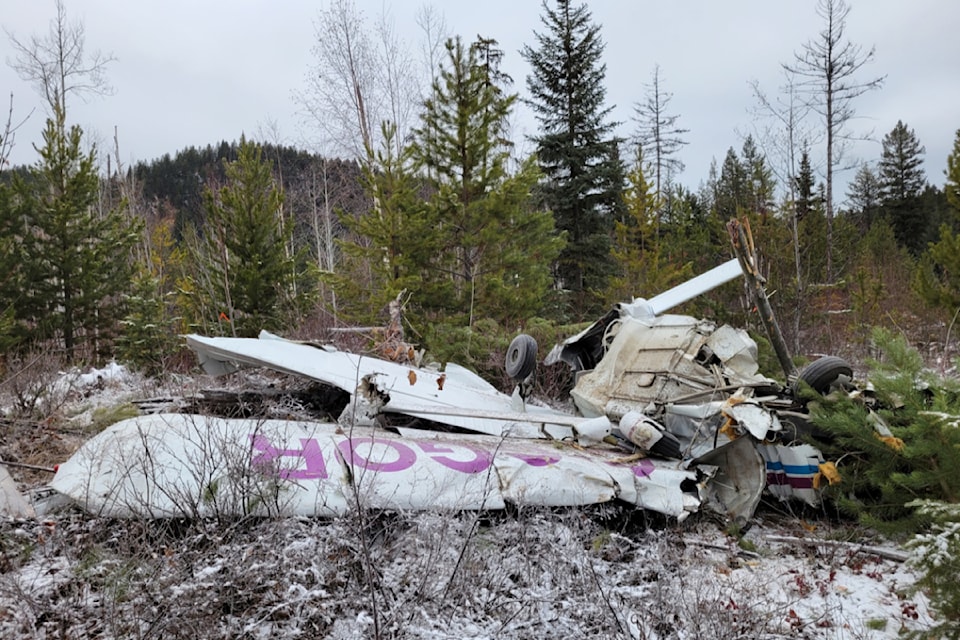A Transportation Safety Board of Canada report says its latest investigation couldn't determine the specific cause of a fatal 2023 plane crash, but some safety maintenance wasn't completed.
On Nov. 24, 2023, a pilot was flying a privately registered PA-28-180 Cherokee aircraft alone to Invermere from Vanderhoof – an average flight time of four hours – before crashing near Brisco, in the east Kootenays. The aircraft was found more than 17 hours after the crash.
READ MORE: Pilot dies following small aircraft crash in East Kootenay
The Transportation Safety Board released its report into the crash Tuesday (Aug. 13).
Shortly after leaving Vanderhoof around 12:43 p.m., it climbed to 3,000 feet above sea level. It levelled off at 9,500 feet around 12:55 p.m. The aircraft continued east and was no longer visible on the radar around 1:30 p.m., near the north end of the Columbia Valley.
Around 2:21 p.m., the pilot texted family to say he was passing Valemount. Just after 3 p.m., the pilot was flying at 11,500 feet for an unknown period of time.
Just before 4 p.m. the aircraft "went into a nose-down attitude, approaching the ground at a high speed" before raising its nose abruptly to a level attitude, rolling to the right as the nose dropped and then crashed."

The Canadian Mission Control Centre didn't receive a signal from the aircraft's emergency locator transmitter and multiple search and rescue helicopter teams were flown in to find the crash site. The aircraft was equipped with an emergency locator transmitter, but it didn't activate during the crash and was found in the "off" position by rescue crews.
Following the crash, the aircraft came to a rest in a wooded area in an "inverted attitude." The plane was was destroyed.
The Transportation Safety Board said the pilot held a private pilot licence, issued in July 2022, with 243 hours of total flight time. About 170 of those hours were in the aircraft the pilot was flying when he crashed. Based on the aircraft's journey logbook, the pilot had flown the route on a regular basis in the previous 10 months.
"There was no indication that the pilot’s performance during the occurrence flight was affected by pre-existing medical factors," the report notes.
Weather wasn't considered a factor in the crash, as there was "no cloud ceiling and the visibility was greater than 20 statute miles" at the time and location of the crash.
The report adds that the pilot had a history of fuelling the aircraft with 91-octane gasoline – more commonly known as MOGAS – which is used for both boats and automotive. The aircraft's handbook, however, requires it be fuelled with aviation-grade fuel.
In order to operate the aircraft with something other than aviation-grade fuel, a supplemental-type certificate is require.
The Transportation Safety Board report says that records available to investigators didn't indicate a certificate had been completed, and a physical examination of the aircraft wreckage determined the modifications required by the supplemental-type certificate had not been completed.
"However, it could not be determined if this was a contributing factor to the outcome."
Carbon monoxide poisoning was determined to not be a factor in the crash, but an airworthiness directive wasn't completed and was overdue by eight months. The directive is typically done to inspect the cabin heater to reduce the risk of poisoning.
The investigation did determine that the aircraft wasn't equipped with with oxygen masks, or supplemental oxygen. Flying an unpressurized aircraft at altitudes above 10,000 feet above sea level without the use of supplemental oxygen can lead to hypoxia, but the investigation couldn't determine how long the aircraft was operated above 10,000 feet for.
The Transportation Safety Board's report ended with a safety message.
It reminded pilots of supplementary oxygen requirements when operating cabin-pressure altitudes above 10,000 feet above seal level. It also added that pilots should ensure that automatic fixed emergency locator transmitters are properly installed, serviced and armed for them to perform their intended function.



